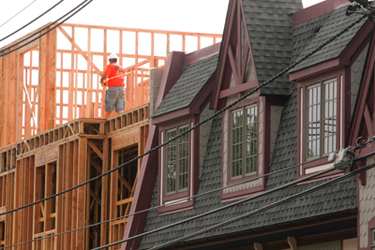SIDEBAR: Apartments Near Transit Fared Thrived through Housing Slump
Apartments Near Transit Thrived through Housing Slump
Transit-oriented development (TOD) in New Jersey appears to have fared comparatively well through the national real estate slump. Representatives of apartment projects that opened during the last few years say leases were signed at a torrid pace, as the recession and other regional economic trends altered where people wanted to live.
“[The housing crisis] boosted the popularity of [TOD] immensely,” said David Minno, whose firm, Minno & Wasko Architects and Planners, has designed TODs in Cranford, Jersey City, Harrison, Maplewood and Rahway to date. “With the tighter economy and gasoline prices going up, it made people think twice about living deep in the suburbs. They wanted to be connected to transit.”

Builders work on a new transit-oriented development project across from
Fanwood Train Station.Nationally, this has proven true with two demographic groups in particular—empty nesters and millennials. For empty nesters, having services like shopping, doctor’s offices and cultural events within walking distance has been a major draw. Millennials also value walkable communities while placing a premium on public transportation access to major job centers. Neither groups is interested in having a big house on a big property—empty nesters because their children have all moved out, and millennials because they’re having fewer of them than previous generations.
“There was some pent-up demand for people who wanted to grow in place, or didn’t want the maintenance of a single-family home anymore, or they’re just starting out and they don’t want the maintenance,” David Checchio, a representative of Fanwood Crossing mixed-use development, said of the project’s reception in the borough. Checchio credited the strength of TOD projects as being an important part of the New Jersey development industry’s survival through the Great Recession.
Edward Kouzma, project manager for the Riverfront at Cranford Station, said the 108 units in the development’s first two buildings filled to 100 percent occupancy within months of opening in 2013, with a rough split of 60 percent empty nesters and 40 percent younger commuters. Minno said 120 units were leased in the first month— a clip he called “outrageous”—at 18 Park, a high-rise his firm designed near a light rail station in Jersey City.
Minno views the skyrocketing cost of rental housing in New York City as the main driver of TOD’s success in New Jersey. Neighborhoods in the outer boroughs that were seen as undesirable a few years ago are now prohibitively expensive. As a result, city commuters are being pushed deeper into New Jersey, and TOD developers are capitalizing on the demand. Even with the housing market inching back to its pre-recession self, the strong TOD market seems here to stay.
“The recession did a good thing—it had people rethink their priorities,” he said. “It sort of showed people how unsustainable a lot of suburban life is. TOD is a more sustainable solution to life.”
Karl Vilacoba is the managing editor of InTransition.